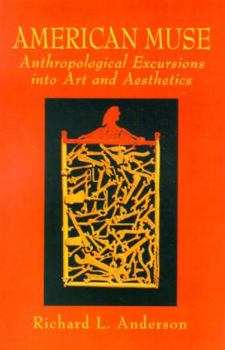American Muse: Anthropological Excursions Into Art and Aesthetics
This clear, lively book approaches its subject using the traditional methods of cultural anthropology--in-depth interviews with "native" informants, examination of "native" sources, and analysis of... This description may be from another edition of this product.
Format:Paperback
Language:English
ISBN:013084313X
ISBN13:9780130843135
Release Date:December 1999
Publisher:Pearson
Length:256 Pages
Weight:0.75 lbs.
Dimensions:0.6" x 6.0" x 9.0"
Customer Reviews
1 rating
American Muse: Review
Published by Thriftbooks.com User , 17 years ago
Anderson, R. (2000). American Muse: Anthropological excursions into art and aesthetics. Upper Saddle River, NY: Prentice Hall Pub. ISBN: 0-13-084313-x Compared references: Foster, H. (Ed.). (1998). Anti-Aesthetic: Essays on postmodern culture. New York: The New Press. ISBN: 1-56584-742-3 Feagin, S. & Maynard, P. (Eds.). (1997). Aesthetics. Oxford: University of Oxford Press. ISBN: 0-19-289275-4 Anderson's (2000) research takes an in-depth look at American art and aesthetics of the local people of Kansas City, Missouri. Anderson's (2000) text welcomes the reader to participate in American tradition or to step out side of their own traditions in order to view culturally induced aesthetic themes that arise about art in America. This vantage point is unique, when comparing it to other texts which focus on aesthetic viewpoints of artistic thought, in that it is written from a culturally focused anthropological viewpoint. Edited books, like Foster (1998) and Feagin & Maynard (1997), consist of a variety of individual aesthetic viewpoints about culture and art that originate from assorted decades. These two texts, however dissimilar in their construction, are in many ways complementary to one another. For example, as Anderson (2000) dissects concurrent themes arising in his subject's `American' aesthetics about art, the other two texts provide complementary, conflicting and reoccurring themes which show strong influential ties to the subject's viewpoints in Anderson's (2000) text. In short, the organization and content of this text make it flow with ease and intrigue. Anderson (2000) covers a wide range of viewpoints through an exhaustive analysis of his interviews with American informants. He carefully examines his sources and analyzes every aspect of their influence from rites of passage to the aesthetic pleasure that they get from the art that they produce. Through this analysis, Anderson (2000) explores the fine arts, the popular arts and any parallels in between by paying just as much attention to the art of tattooing, yard art, rock and roll, and automobiles as to painting, classical music, and literature. The front cover of American Muse features the artwork of one of the informants who Anderson (2000) interviewed and observed. The artwork is showcased in the center of the book's cover. Its bright colors of red-orange and yellow are highlighted by it's placement on a black background and these same two bright colors are echoed in the main color of the book cover and the title. The overall layout of the book cover is a simple symmetrical design. Little has been written concerning critical review of the design of the front cover or of the text itself. However, Anderson's (2000) writing obviously echoes the practiced style of his field. He professionally highlights his citations with sometimes extensive footnotes in order to elaborate on the corresponding passages of the text. Anderson holds a Ph.D. in cultu




